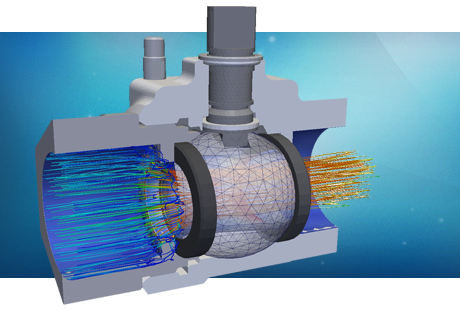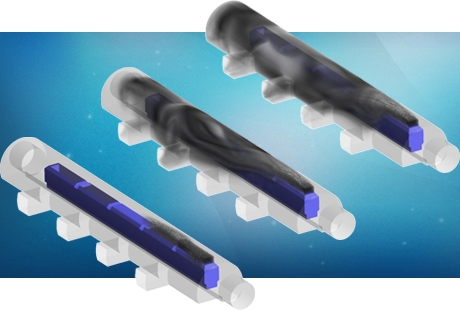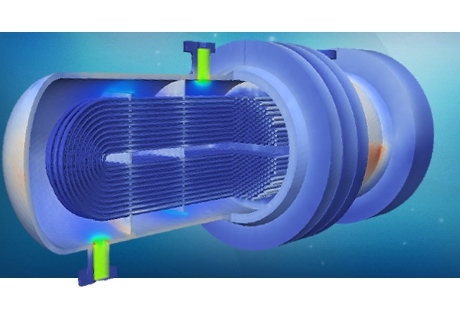Subsea exploration, drilling and completion
During the broad lifespan of an oil field development, a large number of activities are carried out under the surface. Pre-production activities range from the initial exploration and field viability assessment to the well drilling and completion. During the production stage, activities such as downhole production, artificial lifting or EOR activities are carried out (see subsea processing services for more information). Finally, at the post-production stage the decommissioning takes place, the wells are plugged and part of the casing has to be removed.

All these activities take place at depths of miles below the surface and under thousands of feet of water for offshore oil fields. As a result, the financial costs associated with any unexpected failure are enormous. FEA and CFD modelling play an important role in quantifying key risks and evaluating various mitigation/reduction strategies in advance of any detailed design. This typically happens at the FEED stage of the development. PRE Technologies has helped operators and designers to identify, quantify and address technical risk involved in such complex and costly endeavours.
Exploration
The significant financial risks of drilling an unviable well on dry land are only magnified when the unprofitable well is drilled in several thousand feet of water.
 Fortunately, seismic surveys and exploration can save companies millions of pounds by giving them precise information about subsurface features and the likely presence of oil. This subsurface exploration technology requires advanced pulse generators and geophone sensors together with complex data algorithms to interpret the signals. When the survey is carried out offshore a series of pulse generator guns and sensor arrays have to be precisely deployed. PRE Technologies has extensive experience on the design and optimisation of underwater towed arrays. Dynamical stability, force and momentum calculations for different towing conditions and vibrational performance are just some of the types of analysis we offer.
Fortunately, seismic surveys and exploration can save companies millions of pounds by giving them precise information about subsurface features and the likely presence of oil. This subsurface exploration technology requires advanced pulse generators and geophone sensors together with complex data algorithms to interpret the signals. When the survey is carried out offshore a series of pulse generator guns and sensor arrays have to be precisely deployed. PRE Technologies has extensive experience on the design and optimisation of underwater towed arrays. Dynamical stability, force and momentum calculations for different towing conditions and vibrational performance are just some of the types of analysis we offer.
CFD and FEA calculations can also help operators determine the best gun/geophone streamer configuration and also model the air or water gun performance for the specific subsurface structures.
Drilling
When the 3D seismic survey has been successfully completed, it is time to drill the well. With the need to push the oil recovery rate upwards in increasingly challenging oil fields, new drilling technologies have been developed. Directional drilling and subsurface composition real-time monitoring are often combined to maximise the development production levels.

The complete drilling system chain is constantly evolving. New derrick geometries, more powerful and efficient prime movers, more precise draw works, automated top drives and monitored mud handling are just a few innovations currently used. Also with the new directional drilling demands a more versatile and reliable combination of mud-driven drill bits (mud motor, turbo drill and dyna-drill) and a complex positioning systems are required.
FEA analysis has historically helped drilling operators and rig designers in their technical challenges. Stress and vibrational analysis for derrick structures and top drives are often required. Also the drill string and different drill bits have been regularly subject to FEA linear and non-linear analyses. Cone bits, with and without inserts, PDC bits and diamond impregnated bits can be optimised for specific applications using FEA modelling. Rates of penetration (ROP) can be maximised by cleverly designing the cone bit geometry using finite element analysis simulations.

CFD analysis is also broadly applied in drilling operations design and failure analysis. Drilling mud operations are often simulated beforehand according to the specific temperature and pressure conditions of the wellbore. The performance of different mud compositions on different well operational conditions can be tested inexpensively using computational fluid dynamics. Also, unexpected events such as shale rock stuck in the bore and eventual safety hazards such as pressure kicks and blow outs can also be modelled to aid the design of the specific equipment to prevent it. PRE Technologies has vast experience on simulating non-Newtonian and temperature dependant fluids, multiphase flow modelling and transient fluid simulations which are required to accurately capture the mud response to these events.
Completion
When the well has been drilled, it must be completed. Every completion project and casing programme is tailored to accommodate the particulars of the substrate and oil reservoir. Open hole and perforated conventional completions are gradually giving way to more sophisticated completions such as multiple zone and sand exclusion completions.
 Casing programmes need to be adapted to the complex multi-hole well configurations where vertical and horizontal holes need to be secured. Casing deployment and installation often requires additional studies. FEA analysis of the casing joints and interfaces or non-linear analysis of the casing liners and plugs are often demanded.
Casing programmes need to be adapted to the complex multi-hole well configurations where vertical and horizontal holes need to be secured. Casing deployment and installation often requires additional studies. FEA analysis of the casing joints and interfaces or non-linear analysis of the casing liners and plugs are often demanded.
Decommissioning
New regulations such as NTL 2010-G05 require wells that have not been used for a continuous five year period to be decommissioned, permanently abandoned, temporarily abandoned, or zonally isolated. A variety of steps are required for a successful well plugging and abandonment, some of them requiring complex and risky operations. The well must be filled with fluids to prevent hydrostatic pressure collapse and a number of plugs must be placed on the casing stubs, annular space and on the surface. CFD modelling can help decommissioning engineers design and plan these activities. Fluid dynamics calculations for the fluid filling of the different areas and plug performance on different conditions are examples of CFD studies for decommissioning activities.
FEA has an important role to play when designing certain well abandonment operations. Conductor casing severing or pulling is a complex task that often requires very specific and expensive equipment, especially on offshore deep wellheads. Linear elastic stress analysis and non-linear plastic deformation analysis are some examples of models that can help dimension the required equipment for a proper and safe conductor removal and well plugging.
For more information on other services for subsea systems, please go to the subsea services tab or contact us here.
Our services for this sector
Exploration
- Fluid induced vibration on towed and self-propelled survey arrays
- Stability, drag and dynamic calculations on survey arrays
- Stress, vibrational and fatigue studies for array elements and connections
Drilling
- Stress, vibrational and fatigue studies of drill bits and drill strings
- CFD analysis of drilling mud operations (non-Newtonian fluid)
- Structural analysis of derrick structure and top drive
- Stress, vibrational and fatigue studies for drilling ancillary equipment
Completion
- Stress, vibrational and fatigue studies of casing pipes and plugs
- CFD analysis of cementing operations and drilling mud removal
- Casing deployment and installation marine simulation
Decommissioning
- CFD studies for well liquid filling for abandonment
- Non-linear FEA calculation for casing severing and well plugging







